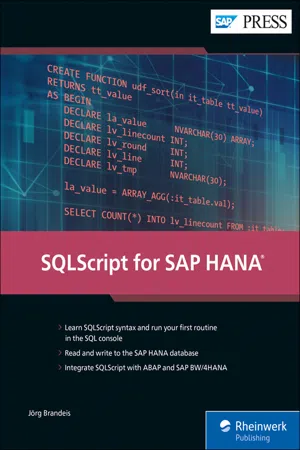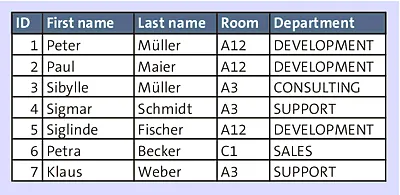
This is a test
- 435 pages
- English
- ePUB (mobile friendly)
- Available on iOS & Android
eBook - ePub
SQLScript for SAP HANA
Book details
Book preview
Table of contents
Citations
Frequently asked questions
At the moment all of our mobile-responsive ePub books are available to download via the app. Most of our PDFs are also available to download and we're working on making the final remaining ones downloadable now. Learn more here.
Both plans give you full access to the library and all of Perlego’s features. The only differences are the price and subscription period: With the annual plan you’ll save around 30% compared to 12 months on the monthly plan.
We are an online textbook subscription service, where you can get access to an entire online library for less than the price of a single book per month. With over 1 million books across 1000+ topics, we’ve got you covered! Learn more here.
Look out for the read-aloud symbol on your next book to see if you can listen to it. The read-aloud tool reads text aloud for you, highlighting the text as it is being read. You can pause it, speed it up and slow it down. Learn more here.
Yes, you can access SQLScript for SAP HANA by Jörg Brandeis in PDF and/or ePUB format, as well as other popular books in Computer Science & Computer Science General. We have over one million books available in our catalogue for you to explore.
Information
1 SAP HANA
The SAP HANA platform is both a database and an application platform. Before we jump into the SQLScript language in the following chapters, let’s first look at SAP HANA as a whole.
With the SAP HANA database, SAP has made performance a top priority—a welcome development because long runtimes have always been a nuisance when using the software. Sometimes, more complex tasks or reports required several minutes!
The SAP HANA database achieves excellent performance through leveraging concepts such as in-memory computing and column-based storage in database tables. The SAP NetWeaver ABAP platform has been enhanced to better leverage these technologies. Enhancements include, for example, the ABAP Managed Database Procedure (AMDP) framework, which allows you to call SQLScript procedures directly from within ABAP code, and core data services (CDS), which can now be used to model complex views on an SAP NetWeaver system. In addition, Open SQL, an elementary component of the ABAP language, has been enhanced with some important features. These changes have also been used to optimize classic SAP applications specifically for SAP HANA. SAP S/4HANA and SAP BW/4HANA are two variants of the SAP ERP system and the SAP Business Warehouse (SAP BW), which have been specially adapted for use with SAP HANA.
In this chapter, we’ll provide an overview of SAP HANA. Section 1.1 deals with the question: What is SAP HANA? Is SAP HANA just a fast relational database, or is there even more behind it? Then, we’ll briefly discuss the system architecture and installation options in Section 1.2.
When developing on SAP HANA, a distinction is made between design time objects and runtime objects. Section 1.3 describes how these two categories of objects are organized in SAP HANA.
Currently, three different development environments for developing applications on the SAP HANA database are available. For most of the examples in this book, only an SQL console is needed. The SQL console is a core component of all development environments. Section 1.4 provides an overview of the different development environments available, while Section 1.5 focuses on the SQL console. Through simple examples, we’ll demonstrate how you can use the SQL console.
1.1 What Is SAP HANA?
SAP HANA, as both a database and platform for application development, contains many practical tools to map all possible application cases. We’ll describe these different aspects in the following sections.
1.1.1 SAP HANA: A Fast SQL Database
The acronym “HANA” originally stood for High Performance Analytic Appliance. SAP HANA is a column-based relational database working with in-memory technology. In this section, we’ll briefly describe the most important technologies that contribute to SAP HANA’s performance.
Column-Based Storage
In SAP HANA, most data is stored in the column store. In other words, all the data in a column is stored together in the same place. Figure 1.2 shows an example of how the data shown in Figure 1.1 can be stored column by column.

Figure 1.1 Table with Sample Data

Figure 1.2 Column-Based Storage of Data from Figure 1.1
Most operations can be performed much more quickly on individual columns than on an entire table. For example, aggregate functions only need the data of a single column. Another advantage of column-based storage is that each column can act as an index. When selecting column values, you do not have to search the entire table, only this one column. Memory consumption is also considerably lower with column-based storage, since efficient compression is carried...
Table of contents
- Dear Reader
- Notes on Usage
- Table of Contents
- Introduction
- 1 SAP HANA
- 2 Getting Started with SQLScript
- 3 Declarative Programming in SQLScript
- 4 Data Types and Their Processing
- 5 Write Access to the Database
- 6 Imperative Programming
- 7 Creating, Deleting, and Editing Database Objects
- 8 SQLScript in ABAP Programs
- 9 SQLScript in SAP Business Warehouse
- 10 Clean SQLScript Code
- 11 Tests, Errors, and Performance Analysis
- A Data Model for Task Management
- B List of Abbreviations
- C The Author
- Index
- Service Pages
- Legal Notes